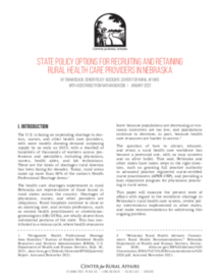The U.S. is facing an impending shortage in doctors, nurses, and other health care providers, with some models showing demand outpacing supply by as early as 2025, with a shortfall of hundreds of thousands of workers across professions and specialties, including physicians, nurses, health aides, and lab technicians. These are the kinds of shortages rural America has been facing for decades. Today, rural areas make up more than 60% of the nation’s Health Professional Shortage Areas.
The health care shortages experienced in rural Nebraska are representative of those found in rural states across the country. Shortages of physicians, nurses, and other providers are ubiquitous. Rural hospitals continue to close at an alarming rate, and certain professions, such as mental health practitioners or obstetrician gynecologists (OB/GYNs), are wholly absent from substantial portions of the state. This has contributed to a vicious cycle, where health resources leave because populations are decreasing or economic incentives are too low, and populations continue to decrease, in part, because health care resources are harder to access.
The question of how to attract, educate, and retain a rural health care workforce has become a perennial one, with no easy answers and no silver bullet. That said, Nebraska and other states have taken steps in the right direction, such as granting full practice authority to advanced practice registered nurse-certified nurse practitioners (APRN-CNP), and providing a loan repayment program for physicians practicing in rural areas.
This paper will examine the present state of affairs with regard to the workforce shortage in Nebraska’s rural health care system, review policy interventions implemented in other states, and make recommendations for addressing this ongoing problem.


